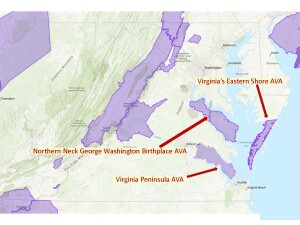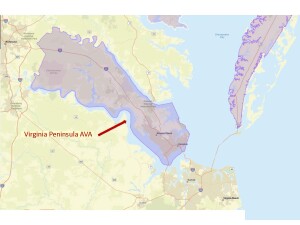On August 25, 2021, the TTB (Alcohol and Tobacco Tax and Trade Bureau) of the United States announced a newly approved American Viticultural Area (AVA) for the Commonwealth of Virginia: the Virginia Peninsula AVA. When this new AVA comes into force—on September 24, 2021—the total number of AVAs in the United States will be 258; of these, 7 will be located in Virginia. Note: Virginia also contains portions of two multi-state AVAs: Shenandoah Valley (shared between Virginia and West Virginia), and Appalachian High Country (shared between Virginia, North Carolina, and Tennessee).
The Virginia Peninsula AVA covers a total of 673,059 acres in southeastern Virginia. The entirety of the area is located on the Atlantic Coastal Plain at elevations ranging from sea level to approximately 250 feet. The area is defined by the York and Pamunkey Rivers to the north and the James River to the south. The counties of James City, York, New Kent, and Charles City as well as several independent cities are included within the new AVA’s boundaries.
According to the original petition, the distinguishing features of the Virginia Peninsula AVA include the following:
Climate: The area experiences a humid/subtropical climate, demonstrated by its long, humid summers and moderate to mild winters. The growing season averages 193 days and typically lasts between April 10 (average date of the last frost) and the end of October/beginning of November (typical harvest dates).
Weather-related challenges in the area include an average of more than 50 days with high temperatures above 90°F during the growing season (and the resulting slow down of photosynthesis) as well as frequent rain approaching the harvest season—as well as the occasional risk of tropical storms.
Geology: The topsoil in this low-elevation coastal plain includes sand, mud, and gravel—much of it formed during times of higher sea levels and/or coastal flooding. The underlying bedrock is marine sedimentary, comprised mainly of sandstone, marine fossils, and clay. These soils are easily fractured and conducive to viticulture.
At the time that the proposal was submitted (in September of 2020), just over 112 acres were planted to commercial vineyards. There are currently at least five commercial vineyards and five bonded wineries operating within the Virginia Peninsula AVA/. These include the Williamsburg Winery, Gauthier Vineyards, New Kent Winery, Saude Creek Vineyards, and Upper Shirley Vineyards.
A wide range of wine types and styles are produced within the Virginia Peninsula AVA. Classic vinifera grapes—including Cabernet Franc, Merlot, Chardonnay, Riesling, and Viognier—are well-represented, as are the (relatively obscure) vinifera grapes Tannat, Petite Verdot, and Petit Manseng. Hybrid varieties—including Norton, Chambourcin, and Vidal Blanc—are grown throughout the region as well.
Welcome to the world, Virginia Peninsula AVA!
References/for more information:
- Petition – Virginia Peninsula AVA
- Federal Register: Establishment of the Virginia Peninsula Viticultural Area
- Virginia Peninsula Named Newest Wine Region In The Commonwealth | Peninsula Chronicle
Post authored by Jane A. Nickles…your blog administrator: jnickles@societyofwineeducators.org

